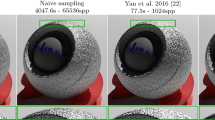Abstract
In this paper, we propose an efficient iridescent rendering method. The iridescent colors on a surface is caused by the different reflection paths of rays with different wavelengths. In microfacet-based rendering model, the dominant reflection path of an incident light ray is statistically described by the microfacet-distribution function (MDF) of the surface. Therefore, the iridescent colors on the surface can be produced by applying different MDFs to different light wave channels. However, it is unnatural for a surface to have significantly different reflection properties in accordance with the light waves. Taking those into account, the proposed method employs identical and anisotropic microfacet distribution function(MDF) for each light wave channel, and rotates the identical anisotropic MDF of each channel with its own angle to produce iridescent reflection. The method also employs multi-peak MDF for the simulation of diffraction effects, and can be successfully applied to iridecent surface such as CD-ROM and mother-of-pearl (nacre) furniture. The experimental results demonstrate that the method enables interactive applications such as games or virtual reality softwares to plausibly express various cases of iridescent surfaces.














Similar content being viewed by others
References
Agu E, Hill FS Jr (2002) Diffraction shading models for iridescent surfaces. In: Proceedings of IASTED VIIP
Ashikhmin M, Premoze S, Shirley P (2000) A microfacet-based brdf generator. In: Proceedings of ACM SIGGRAPH 2000, pp 65–74
Ashikhmin M, Shirley P (2002) An anisotropic phong brdf model. J Graphics Tools 5(2):25–32
Blinn J (1977) Models of light reflection for computer synthesized pictures. In: Proceedings of the 4th annual conference on computer graphics and interactive techniques, pp 192–198
Blinn J, Newell M (1976) Texture and reflection in computer generated images. Commun ACM 19(10):542–547
Cook RL, Torrance KE (1981) A reflectance model for computer graphics. Comput Graph (ACM Siggraph ’81 Conference Proceedings) 15(3):307–316
Cuypers T, Haber T, Bekaert P, Oh SB, Raskar R (2012) 5. ACM Trans Graph 31:122:1–122:11. doi:10.1145/2231816.2231820
Hirayama H, Yamaji Y, Kaneda K, Yamashita H, Monden Y (2000) Rendering iridescent colors appearing on natural objects. In: Proceedings of the eighth pacific conference on computer graphics and applications 2000, pp 15–22
Kajiya JT (1986) The rendering equation. In: ACM SIGGRAPH Computer Graphics, vol 20, pp 143–150. ACM
LACMA: Black-lacquered wardrobe chest with peony and arabesque design (2013). http://collections.lacma.org/node/199634
Moravec HP (1981) 3d graphics and the wave theory. In: ACM SIGGRAPH computer graphics, vol 15, pp 289–296. ACM
Musbach A, Meyer GW, Reitich F, Oh SH (2013) Full wave modeling of light propagation and reflection. Comput Graph Forum 32(6):24–37
Musgrave FK (1989) Prisms and rainbows: a dispersion model for computer graphics. In: Proceedings of graphics interface, vol 89, pp 227–234
Poulin M, Founier A (1990) A model for anisotropic reflection. Comput Graph (ACM Siggraph ’90 Conference Proceedings) 23(4):273–282
Schilick C (1993) A customizable reflectance model for everyday rendering. In: Proceedings of the 4th Eurographics workshop on rendering, pp 73–84
Stam J (1999) Diffraction shaders. In: Proceedings of the 26th annual conference on computer graphics and interactive techniques, SIGGRAPH ’99. ACM Press/Addison-Wesley Publishing Co., New York, pp 101–110. doi:10.1145/311535.311546
Sun Y, Fracchia FD, Drew MS, Calvert TW (2000) Rendering iridescent colors of optical disks. In: Proceedings of rendering techniques ’00, pp 341–352. Springer
Torrance KE, Sparrow EM (1967) Theory for off-specular reflection from roughened surfaces. J Opt Soc Am 57(9):1105–1112
Ward G (1992) Measuring and modeling anisotropic reflection. Comput Graph (ACM Siggraph ’92 Conference Proceedings) 26(2):265–272
Author information
Authors and Affiliations
Corresponding author
Rights and permissions
About this article
Cite this article
Kang, YM., Lee, DH. & Cho, HG. Multipeak aniostropic microfacet model for iridescent surfaces. Multimed Tools Appl 74, 6229–6242 (2015). https://doi.org/10.1007/s11042-014-2092-1
Received:
Accepted:
Published:
Issue Date:
DOI: https://doi.org/10.1007/s11042-014-2092-1




